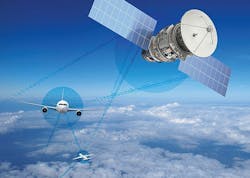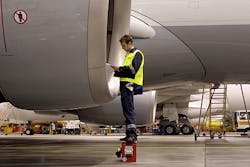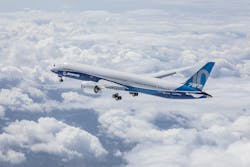By James Sherman, technical conference developer at SAE International
Connected aircraft means more than just in-flight movies, free texting, and Facebook posting with friends while in flight. In fact, the connected aircraft revolutionizes airline operations, dramatically improving fleet management, flight safety, passenger experience, maintenance, flight operations, aircraft turnaround time and costs. For aircraft operators, connectivity presents a new set of operational benefits that were previously unavailable.
Using big data, analytics, and secure communications technology, aircraft operators are now better able to anticipate opportunities – to avoid weather, disruption, and cost, to drive faster turnaround times. Opening the data pipe to and from the aircraft offers great opportunities for flight crews, the fleet managers, air traffic control, maintenance personnel on the ground and more. Suddenly the aircraft becomes a data-rich node on a large network, leveraging new technology and more reliable connections to link an airplane’s components and equipment to immediately send, receive, and analyze data.
The capabilities of the evolving connected aircraft concept go much deeper than allowing airline passengers to surf the internet at 30,000 feet. In the future, the growing prevalence of broadband and satellite-based connectivity options will allow airlines and operators to capture data about the health of critical avionics, systems, and aircraft components in-flight to provide better maintenance scheduling and health trend monitoring of their aircraft fleets.
Even with the perception that aerospace is very advanced and modern, there are a great number of platforms that collect minimal amounts of data per month (yes per month) and that data is transferred to the maintenance system via 3.5” floppy disc! This is not an efficient way to run a maintenance organization – either from the operator, the OEM, or the supplier standpoint. The good news is that the average age of commercial aircraft, for the leading airlines is about 15 years, and getting younger, as airlines replace airplanes. That still means that about half of the fleet was in service at 9/11, well before the advent of pervasive broadband ethernet technologies. The introduction of connected technology in the aircraft leads to nodes in the sky.
What are nodes in the sky? Within all communication networks, a node is a connection point. Air Traffic Management (ATM) modernization coupled with the data centric architectures being incorporated into modern aircraft will create a network in the sky for the future. Aircraft will become nodes within airborne networks, sharing data with other aircraft, ground-based operational teams and Air Traffic Controllers at speeds that current ACARS and ACMS systems are not capable of producing. ACARS and ACMS, while technically connected, offer data rates equivalent of dial-up, and weren’t designed to deliver maintenance data, but rather are primarily used for ground-based operational teams to measure the airborne performance during different phases of flight, such as at cruise altitude or during adverse weather conditions.
How will OEMs, suppliers, and airlines use the capabilities of these nodes in the sky to become more efficient? By streaming data about the condition of the various components and systems of the aircraft to ground-based teams so that key maintenance issues can be highlighted, and teams are prepared to handle them as soon as the aircraft lands. The data will be shared back through the supply chain, so not only the operational teams get a better grasp on how the aircraft performs but the manufacturers get data to improve their products.
Better connectivity can have different benefits for different parts of the aircraft, for example, the aircraft braking system on most passenger jets today is monitored by the brake control system and maintenance teams determine whether a repair is necessary through a physical measurement of a wear device on the brakes. Being able to monitor brake wear in real-time, greatly improves the process. Real-time connectivity allows aircraft operators to monitor flight to flight and even out wear on brakes to extend life and reduce maintenance costs and proactively stage parts.
The growing availability and prevalence of higher speed broadband and satellite communication (satcom) systems provide speeds of up to 40 to 50 Mbps. Airlines, operators, and suppliers are starting to take advantage of that capability to enable more efficient and speedier sharing of real time data about the in-flight performance of their aircraft. This will help their operational teams provide better maintenance schedules, reduce aircraft down times and report trends back to aircraft and avionics manufacturers who can then use that data to improve future products and introduce software updates to improve existing products.
Airframe manufacturers are also getting into the connected aircraft business. Boeing is evaluating the possibility of offering a satellite-based In-Flight Connectivity (IFC) system as a line-fit option on its 737s, 777s, and 787s. Having that type of connectivity on the aircraft from the production line would help operators of the 787 — which generates up to 146,000 parameters of data per flight — capture better data about the health of the aircraft while it is being operated. According to John Craig, chief engineer of cabin and network systems at Boeing, one of the major aspects of connectivity that needs to be addressed is security. Streaming data in real time will greatly enhance operational efficiency for airlines and operators, but as the industry moves forward with these new solutions, this will need to be done securely.
“Connectivity will drive cyber solutions. We live in a safety world and the whole industry is very good at it,” says Craig. “Cybersecurity is a new paradigm in aviation, we’re going to have to protect the airborne and the ground interfaces.” Boeing also believes that there is real value in enhancing connectivity options for operational and maintenance purposes. Airlines incur billions of dollars of expenses annually, so if they’re able to gain operational efficiencies in terms of reducing fuel burn, increasing flight crew situational awareness and on time performance, then “there is some real value we can get out of connectivity,” Craig says.
All of this and more will be discussed in detail at the SAE 2018 Aerospace Systems and Technology Conference, being held November 6-8 in London, UK. I invite you to attend and get the whole picture.



